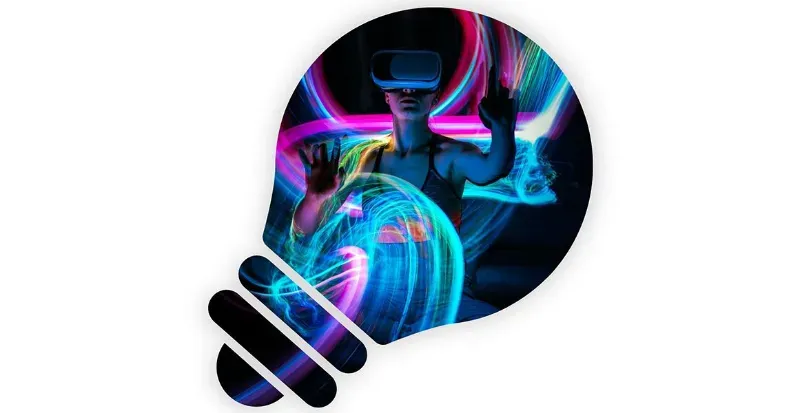6 Characteristics of an Open Metaverse

In the metaverse, we are only bound by our creativity and the resources at our disposal. Because it is digital, anything can be created as long as we set our minds to it. After all, in the digital world, the laws of physics do not apply, even if we interact with the physical world.
As a futurist, I always tell organisations that a change in perspective is crucial to having an open mind when constructing the virtual worlds and experiences in the metaverse. When developing a metaverse experience, be it a brand to engage with their customers, game developers who wish to build an immersive social game, or industrial companies planning to incorporate digital twins in their supply chains, you are no longer bound by real-world scarcity or limitations.
Consequently, mimicking the real world in the virtual world does not make sense. In the metaverse, there is infinite space. Users can quickly teleport from one experience to another, so creating, for example, artificially scarce digital real estate, although beneficial to a small group of insiders and as a new way to raise funds for a startup (similar to the initial coin offering (ICO) hype in 2017), does not make sense at all if you take on this different perspective.
Six Characteristics of an Open Metaverse
In the metaverse, you can be who you want to be, create what you want, where you want, for whom you want, and how you want. This complete freedom for creators will undoubtedly lead to some fascinating experiences, but for the open metaverse to work, there are six characteristics that creators (individuals, startups, brands, enterprises, and even governments) should be taken into account when building for the metaverse:
- Interoperability;
- Decentralization;
- Persistency;
- Spatiality;
- Community-driven;
- Self-sovereignty.
Let's discuss them individually to get a complete picture of how we can create an open metaverse offering unique experiences.
If reading is not your thing, you can also watch this 4-minute video to have a clear overview of the six characteristics of the open metaverse:
Interoperability
If we want to create a bigger pie, instead of obtaining a bigger slice of the same pie, interoperability will be essential. It can make the network bigger and increase the external value of a network to consumers. Lack of interoperability keeps users inside a platform once they are in, which is predominantly beneficial to the network owner. A great example is WhatsApp. Over the years, WhatsApp has achieved powerful network effects because the more of your friends with a WhatsApp account, the easier it would be to connect with your friends.
Interoperability is all about to what extent users can take out the value they created inside one platform and bring it to another platform and vice versa without any barriers. Interoperability would enable users to win, buy or earn a digital asset in one environment and use it in another, whether physical or digital. Interoperability allows users to transfer their data and assets from one platform to another and sell it to other users at the market value determined by the open market. The more seamless the experience is, the more overall value the metaverse will create for society.
Interoperability can be achieved by creating standards, protocols, and development frameworks that everyone agrees to use, similar to the standards and protocols that enable email or the application programming interfaces (APIs) that make it easy to connect disparate platforms. However, there are also challenges when it comes to ensuring interoperability for the metaverse, and it will require more than just global standards, protocols, or frameworks. We also need to agree upon functionality and rules to enable interoperable assets that can be used in multiple virtual worlds.
Obviously, we want to prevent that you can use your rocket launcher from Grand Theft Auto during the meeting with your colleagues if you think that the meeting takes too long or your colleague is annoying you again. In addition, different worlds follow different designs and taking an asset from a low poly world (such as Minecraft) to a high poly world (such as Fortnite), or vice versa, might break the user experience or the entire environment.
Decentralization
While interoperability enables the exchange of assets across virtual worlds or experiences, decentralization is about who controls those virtual worlds, assets, and experiences and who reaps the benefits if it becomes a success. The vision for the web has always been one of complete decentralization, where the power lies with the individuals and not with Big Tech or governments who can use centralized platforms to control, exploit and manipulate individuals. Digital ownership and control of data are critical here, and it will be vital that we fix the flaws of Web 2.0 and create a metaverse controlled by no one and owned by everyone.
This is where blockchain comes into play and the various blockchain technologies that have been developed in the past decade. The metaverse should rely on a decentralized single source of the truth when exchanging value among stakeholders, whether consumers playing various games or enterprises as part of a supply chain. In a decentralized metaverse, thanks to cryptography, data becomes immutable, verifiable, and traceable, foregoing the need for a trusted intermediary to manage the source of truth of the information at hand.
This means that the provenance of either data and (digital) products will ensure efficient value exchange and complete transparency. Thanks to blockchain and smart contracts, the settlement of transactions can take seconds.
Smart contracts are a critical aspect of NFT as it embeds the rules linked to them. As a creator of the NFT, you can decide what rules you attach to an NFT, for example, how people can use the NFT online and what rights (if any) are attached to it, etc.
Decentralizing the metaverse will be crucial for its success, especially if we require interoperable digital assets. Decentralization in the context of the metaverse is all about proving ownership of (digital) assets and having full control over your identity, reputation, and data (self-sovereignty).
However, decentralization is not about using blockchain technology to decentralize computing power, bandwidth, or data storage, yet. While these solutions are already available, it will be a long time before we can use blockchain as a digital infrastructure to power the metaverse because interactive, real-time immersive experiences will require (ultra) high-definition, low latency, and extreme bandwidth, which cannot yet be delivered by blockchain technology (which is why Jack Dorsey coined the confusing term Web 5 (as in Web 2 + Web 3 = Web 5).
Nevertheless, decentralization is crucial for the metaverse as it empowers the end-user, lets creators connect directly with fans at scale, limits censorship, and ensures cryptographic trust in a trustless (as in no intermediaries) environment.
Persistency
The metaverse will be an always-on, persistent internet where experiences, whether virtual or augmented, remain available and online for anyone to experience who has access to it and for as long as the creator decides.
This persistency applies to augmented reality experiences and to virtual worlds, which would enable synchronous virtual experiences that could evolve and are always there for users to explore. Like the real world, a persistent metaverse should stick around, even if you leave.
For example, if you have augmented reality experiences pinned at a particular location in the real world, they are always there unless the creator decides to remove them. So, a flying dragon above Times Square can be seen by anyone looking up with AR glasses, their phone or tablet, and the right app on their phone or glasses. Depending on their physical position in Times Square, they will see a different perspective of the same dragon.
If we take this a step further, and you would visit Times Square in virtual reality, you will also see the same dragon flying above the world-famous square. In a genuinely persistent metaverse, which is probably at least a decade away, those in virtual reality can see the avatars of the people watching the dragon on Times Square, and the avatars of those viewing the dragon in virtual reality would become visible to those looking through AR glasses in the real world. It would be a truly persistent XR experience, co-present in the real and virtual world.
The key to a persistent metaverse is that content can only be deleted by the creator, similar to how in the real world, buildings are persistent and can only be removed with permission from the owner. This could also pose a risk as this technology could also be used by criminals or terrorists, who could potentially publish defamatorily, offensive, or illegal content, e.g., a terrorist recruitment poster, which becomes persistent and impossible to remove. Therefore, platforms that allow users to drop augmented experiences in the real world should have specific rules that prevent users from dropping any content, but that is similar to your local government that does not allow the development of just any building.
A persistent metaverse would create infinite (monetization) opportunities for artists and content creators to enrich the digital and virtual worlds, as their efforts can be rewarded, and revenues can be received instantly without banks. For example, Banksy could drop a virtual painting on a high-traffic location in London, and you would only be able to view it if you are at that specific location and would pay a small amount of money in crypto. Since the virtual painting would be persistent, it would remain there indefinitely unless Banksy deleted it.
Spatiality
A metaverse that is not spatial is a metaverse with limited opportunities. Any virtual world, space, or experience should incorporate spatial anchors to make objects inside those virtual or augmented experiences persistent so people can find them and provide an experience that is more akin to the real world, which can be further reinforced using spatial audio.
Spatial data will enable users to interact with digital items, whether placed in the virtual or real world, in the most natural way using our five senses (or even future senses, as mentioned earlier). Spatial computing would translate physical actions (movements, speech, gestures) into digital interactions in the virtual or augmented experience. The keyword here is location, which determines where users (avatars) or digital assets and spaces are to be placed or moved in the physical and/or virtual world.
Each thing, user, or space should obtain a unique identifier, governance and interaction rules (ideally embedded in the code using smart contracts recorded on the blockchain), and verifiable provenance for stakeholders to interact with and have a perfect copy in either the physical or digital world.
To get back to the example of the dragon above Times Square, spatial data would make the dragon persistent, enable users to experience it from different perspectives and even hear audio based on their location relative to the dragon in the air. Spatial data would also open up new monetization opportunities by having, for example, different price strategies based on the distance to the virtual object.
Spatial data will make our physical and virtual worlds smarter by adding context and intelligence to any object, space, or user. It will enable real-time interaction and collaboration and provide an intuitive experience for humans and machines. It will also enable finding our way in the metaverse.
Remember, in the metaverse, there is no Google, yet. This will change in the coming years when either Google or a future startup will step into this void and enable users to find whatever they need across millions of experiences and digital objects. Without these spatial anchors, the metaverse would be a floating, non-persistent and chaotic world, and it would be impossible to find anything.
Community-driven
Humans are social creatures by nature, so it is no surprise that the metaverse will primarily be a social experience, not counting exceptions.
Even those VR experiences that can only be experienced alone often add a social component such as a leader board or other gamification techniques. For any metaverse experience, the community will be crucial, whether an experience is designed around a community or created by the members.
To that end, the metaverse is not any different from the real world, where people come together and form a community around whatever topic as belonging to a group has always been crucial for individual survival.
This can be a niche community such as a metaverse space for wine lovers or a broad community focused on massively multiplayer online role-playing games (MMORPGs). The metaverse can bring communities to another level, where community members can have real-time, shared, immersive, and even owned experiences. A core trait of successful games, such as Fortnite, Axie Infinity, or Minecraft, is enabling social experiences, and the same will be true for the metaverse.
Brands that want to step into the metaverse must acknowledge the existing community and not pretend to know better than the community. Respect for, learning from, and interacting with the community are crucial to success in the metaverse.
Today, brands and organizations find their community on social media platforms, and websites are often merely a showroom of what the brand has to offer. Almost all brands interact with their community on those social media platforms where their users are, instead of bringing the community to the company's website.
The same will apply to the metaverse, and brands should go there where their community is. In addition, the metaverse offers an opportunity to create unique, immersive brand experiences made with the community and potentially even controlled and owned by the community.
Self-sovereignty
The last characteristic of an open metaverse is self-sovereignty, which means that the individual remains in control over their online identity and data, instead of the platform or website.
A self-sovereign identity and/or reputation has long been the objective of Web 3, and it is one of the most important characteristics we have to get right if we want to create an open metaverse. In the past decades, self-sovereignty has not been on the agenda as we too much enjoyed the free services provided by Big Tech. As a result, we have ended up in a situation where users have digital identities that are not self-sovereign but controlled by companies who can delete your (online) identity with a click of a button. Self-sovereignty is crucial if we want to achieve an open, decentralized, and interoperable metaverse.
Self-sovereignty is the idea that individuals, but also things, should have control over their own data, identity, reputation, and information on the internet without relying on any one company or government entity for protection or any intermediary controlling their data or identity. People can regain sovereignty over their identity and data using blockchain technologies, including zero-knowledge proofs.
Within the metaverse, proving your identity, or proving that you are whom you say you are, will become more critical than ever before because, with avatars, it will be relatively easy to impersonate someone by creating a digital copy of the avatar they usually use.
With advancements such as Reallusion Character Creator 4 or the Unreal Engine’s MetaHuman Creator, it has become easier than ever before to create an exact copy of a celebrity, politician, or entrepreneur and use deepfake audio to have him or her do and say whatever you want in any digital environment. Unless the celebrity, politician, or entrepreneur can cryptographically prove that they are the one who owns and controls the avatar or digital human, we will open Pandora's box of disasters.
Final Thoughts
An open metaverse is all about value creation and value exchange. An open immersive internet will enable humans to interact with one another and ultimately control how they organize their lives in the metaverse. Any platform building something for the metaverse should incorporate these characteristics in some form or shape if they want to contribute to the open metaverse and be there for the long run.
If we can make self-sovereignty a cornerstone of the metaverse, it will bring us closer to a truly open and decentralized metaverse, owned and controlled by the community instead of corporations. It would enable us to move from programmatic information exchange as part of Web 1.0 and Web 2.0 to programmatic value exchange as an intricate part of Web 3.0, whereby users can build code components on top of their sovereign assets that do exciting things with those assets to increase value for the overall system, without being dependent on intermediaries that could cut them off from the ecosystem.
In other words, these six characteristics of an open metaverse are a paradigm shift from today's system, empowering users and creators to take their digital lives into their own hands.
This is an abstract of my new book. In this book - Step into the Metaverse: How the Immersive Internet Will Unlock a Trillion-Dollar Social Economy – I discuss these six characteristics of an open metaverse in-depth. Step into the Metaverse is available now.
Image: Envato





